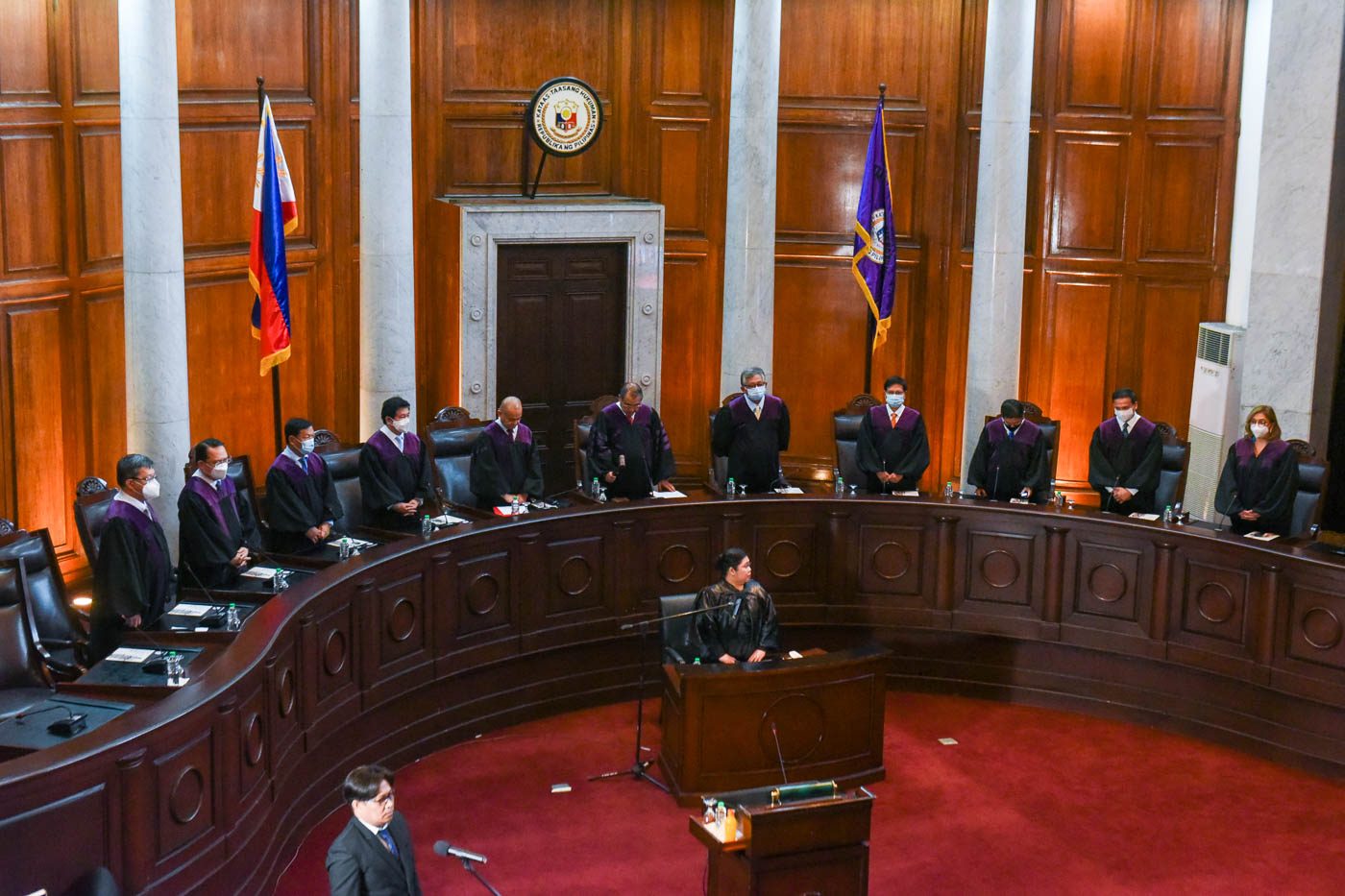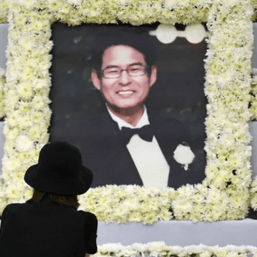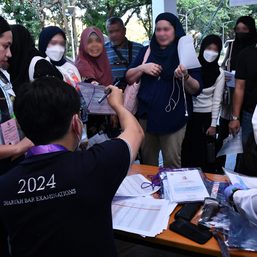SUMMARY
This is AI generated summarization, which may have errors. For context, always refer to the full article.

MANILA, Philippines – The Supreme Court (SC) has finally defined red-tagging as an act that threatens individuals.

In a 39-page decision penned by Associate Justice Rodil Zalameda, the High Court defined red-tagging as an act that threatens a person’s constitutional right to life, liberty, and security.
The decision publicized on Wednesday, May 8, said red-tagging is the use of threats and intimidation to “discourage subversive activities,” adding that “whether such threats ripen into actual abduction or killing of supposed ‘reds’ is largely uncertain.”
For years, progressive individuals and activities have been fighting red-tagging, or the act where people in power link individuals to communist groups. Red-tagged individuals end up arrested, sued, abducted, or worse – killed.
The SC decision stemmed from a petition filed by Siegfred Deduro, a founding member and vice president for the Visayas of Bayan Muna and the Makabayan Coalition. Daduro’s counsel is AK Guillen of the National Union of Peoples’ Lawyers (NUPL), the lawyer who survived a stabbing attack in Iloilo in 2021.
In his petition, Deduro sought the issuance of a writ of amparo, a legal remedy which is usually a protection order in the form of a restraining order, for the red-tagging attacks against him by the military.
The SC said in the decision that several organizations had already acknowledged red-tagging as a form of harassment and intimidation. The High Court cited a United Nations (UN) Human Rights Council report which found that red-tagging is used to characterize leftist groups as “front organizations of anti-democratic groups.” The UN body also called it as “vilification,” “labelling,” or guilt by association.
The High Court also took note of red-tagging’s transition to social networking sites like Facebook. The SC cited the 2020 report of the United Nations High Commissioner for Human Rights, which said that red-tagging comes “frequent surveillance and direct harassment.” The SC added that in the report, the UN said red-tagging can also lead to death of targeted individuals.
“The foregoing accounts of red-tagging depict it as a likely precursor to abduction or extrajudicial killing. Being associated with communists or terrorists makes the red-tagged person a target of vigilantes, paramilitary groups, or even State agents,” the SC said in its decision.
“Quite like the development of the Rule on Amparo, the damages inflicted by red-baiting evolve too: They start from the psychological before they turn physical. Amid a history of shifting social and political ties, we affirm the Judiciary’s sworn duty to see to it that the protection of every right guaranteed in the Constitution remains constant for all,” the High Court added.
In the decision, the High Tribunal said the red-tagging of individuals may justify the issuance of a protection order through the writ of amparo.
“It is at this phase where the petitioner is at risk of enforced disappearance or extrajudicial killing when the writ of amparo becomes necessary,” the SC added.
A big win
This was the first time that a Philippine court has explicitly defined red-tagging.
Even in past decisions that were favorable to progressive individuals, no definition of red-tagging was given. The closest reference to the said act was Senior Associate Justice Marvic Leonen’s dissenting opinion on the Zarate vs. Aquino III case, where Leonen called “red-baiting” as “our version of McCarthyism,” a term used in the United States to refer to the “red scare.”
The SC’s explicit definition is important because it did not only reaffirm that red-tagging is dangerous, but also provided legal basis for individuals who will challenge the act. The lack of definition of red-tagging was advantageous for government officials and influencers. When authorities were challenged for red-tagging, they denied red-tagging’s existence because there was no legal framework that defined it.
“At long last, the SC has finally spoken categorically, unequivocally and clearly that Red-Tagging Threatens Right to Life, Liberty, and Security. It is not a mere legally meritorious victory, nor a vindication and potential shield of human rights defenders and a tribute to those fallen and already victimized by it, but a strong slap on self-righteous red-taggers before & now, particularly those who would even spin and distort what the Court say,” NUPL chairperson Edre Olalia said.
For Kristina Conti of NUPL National Capital Region, the SC decision “cautions” lower courts against dismissing petitions for a writ of amparo without proper hearing, since the SC itself said red-tagging justifies the issuance of the protection order.
Leonen concurs
In his concurring opinion, Leonen reiterated that the issuance of a writ of amparo is justified when there is red-tagging, “vilification, labeling, and guilt by association threaten a person’s right to life, liberty, or security.” Leonen also mentioned his 2015 dissenting opinion, where he outlined the dangers inherent to red-tagging.
“As astutely stated in the ponencia, a person seeking the protective ambit of a writ of amparo need not await the inimical outcomes of being red-tagged to come to pass to be entitled to the writ,” the senior magistrate said.
“The heightened risk of danger or death brought about being labelled as a Communist, a Communist sympathizer, or even merely being adjacent to a Communist cause should be seriously considered by judges in amparo proceedings,” Leonen added.
The case
Citing red-tagging attacks against him, Deduro sought the court’s help for the issuance of a writ of amparo. The respondent in the case is Major General Eric Vinoya in his capacity as the commanding officer of the Philippine Army’s Third Infantry Division. Deduro said the military red-tagged him and accused him of being a ranking member of the Communist Party of the Philippines-New People’s Army.
Deduro was among the activists red-tagged through posters in the Visayas, along with Iloilo-based Jory Porquia, Bacolod activist Zara Alvarez, and NUPL lawyer Benjamin Ramos. Porquia, Alvarez, and Ramos were all shot and killed by unidentified assailants.
The activist first sought the Regional Trial Court’s help, but the RTC immediately dismissed his petition in 2020. The lower court said it found Deduro’s “allegations of red-tagging baseless, unsupported by evidence, and insufficient for the grant of the extraordinary writ.” Deduro then brought his case to the High Court.
In its ruling, the SC partially granted Deduro’s petition and issued a writ of amparo in favor of him. The SC also reversed the RTC’s ruling that denied Deduro’s request for the extraordinary writ.
However, the SC only granted the petition, and not yet the privilege of writ of amparo. The RTC will set a hearing that will determine if the privilege of the writ would be granted. The privileges of writ of amparo can include a permanent protection order, which functions like a permanent restraining order – With a report from Lian Buan/Rappler.com
1 comment
How does this make you feel?
![[OPINION] Badoy’s red-tagging and freedom of expression](https://www.rappler.com/tachyon/2024/04/20240426-Badoy-red-tagging-freedom-expression.jpg?fit=449%2C449)
![[OPINION] Social media and limits of protected speech](https://www.rappler.com/tachyon/2024/04/TL-badoy-red-tagging-2-apr-27-2024.jpg?fit=449%2C449)







“I am grateful for Associate Justice Rodil Zalameda’s recent Supreme Court ruling. The decision defines “red-tagging” as violating a person’s constitutional right to life, liberty, and security. Thank you for safeguarding the Constitutional Rights of all Filipinos.”